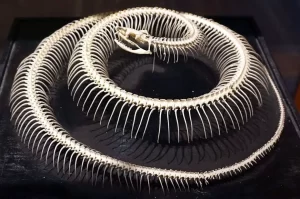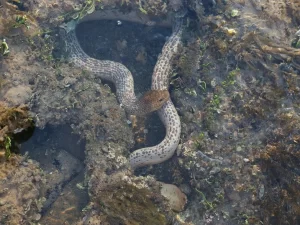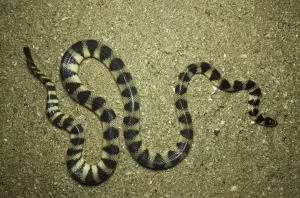Sea snakes are interesting creatures that live in marine environments for most of their lives. These snakes are excellent swimmers and often dive to the sea floor to hunt. But how long can sea snakes stay underwater?
Most sea snakes spend an average of 15 to 30 minutes underwater before returning to the surface for air. However, many sea snakes can stay underwater for up to 2 hours, under the right conditions; and a few species – as long as 8 hours.
Exactly how long a particular sea snake can stay underwater is mainly influenced by the species, how active the snake is, and the water temperature.
For example, a resting sea snake may be able to stay submerged for several hours, while an individual who is escaping a predator or chasing prey may need to resurface often.
Sea Snakes Need to Resurface to Breathe Air
Like all reptiles, snakes have lungs, that they use to breathe air. Due to their elongated bodies, snakes do not have lungs that are located side to side, like ours.
Instead, they have one shorter and one very long lung in a series. In most species, the left lung is the smaller one and is roughly 85% of the length of the elongated right lung.
Some species only have one elongated lung, and the smaller lung is absent.

The longer lung occupies around 30 percent of the body length in boas (Boidae), and as much as 80 percent of the body length in some colubrids (Colubridae) and elapids (Elapidae). Sea snakes generally fall into the Elapidae family.
In many snakes, the smaller left lung is vestigial, and all gas exchange happens with the longer lung.
How Snakes Breathe
To breathe, snakes take air down into their lung (s). Once the air is in the lungs, oxygen from the air is then absorbed into the snake’s bloodstream. At the same time, carbon dioxide from the bloodstream is diffused into the air.
That said, it’s important to note that snakes do not possess a diaphragm, to move air in and out of their lungs, as mammals do.
Instead, they respire using their ribs.

In between each rib, are muscles that help force air out of the lungs. To breathe in, the muscles contract, and air rushes into their lungs -and to breathe out, the muscles relax and, air leaves the lungs.
While underwater, sea snakes return to the surface periodically to replenish their oxygen stores and expel waste gases – with their lungs.
Sea snakes have nostrils with valves consisting of specialized spongy tissue to exclude water.
In addition, their windpipe can be drawn up to where the short nasal passage opens into the roof of the mouth.
This adaptation allows them to have their heads partially submerged when they surface to breathe air.
Why Do Sea Snakes Dive Underwater?
Like many other animals, sea snakes adapted to their environment. Their adaptations allow them to be in their aquatic habitats.
The main reason they dive and stay submerged is to hunt for food among coral reefs, mangroves, or on the ocean bottom of coastal areas.
They can hide among debris in the water, and wait for hours to ambush their prey.
How Long a Sea Snake Can Stay Underwater Is Mainly Dependent on 3 Factors
How long a sea snake can stay underwater after is mainly dependent on 3 factors, namely: the species, how active the snake is, and the temperature.
Depending on these factors, most sea snakes can stay underwater anywhere from 30 minutes to as long as 2 hours at a time.
However, a few species can stay underwater for as long as 8 hours!
1. Species
Some sea snake species are more adept at holding their breath than others and thus can stay underwater longer.
For example, Olive sea snakes (Aipysurus laevis) are known to spend up to two hours underwater before returning to the surface to breathe.

Other sea snakes may only spend 15 to 30 minutes underwater before returning to the surface for air.
When surfacing to breathe, most sea snakes often only pause for less than 1 minute before submerging again.
2. How Active the Snake Is
Activity affects how much oxygen the body needs.
Think about it. When you are running or jogging, you breathe in much quicker breaths than when you are lying on the couch.
For sea snakes, this is also true. Their oxygen demands will be influenced by their activity levels.
A sea snake that is resting on the bottom of the water may be able to stay submerged for several hours.
On the other hand, an individual of the same species who is escaping a predator or chasing prey – may only be able to stay underwater for 15 minutes before needing to surface to replenish its oxygen supply.
3. Temperature
Like all reptiles, sea snakes are cold-blooded (ectothermic) animals.
This means they cannot internally regulate their body temperature. Instead, their body temperature changes with the temperature in their surroundings.
In other, their environment is the main influence on their body temperature.
For example, a sea snake swimming in 30°C (86°F) water has a body temperature very close to 30°C. In water at 15°C (59°F), the body temperature is around 15°C.
Being ectothermic means sea snakes will have a varied rate of metabolism, depending on the water temperature.
Warmer water temperatures increase metabolic rates. This means sea snakes have to resurface more often to get oxygen.
On the opposite end, cooler water allows sea snakes to conserve oxygen. This extends the time they can hold their breath.
Can Sea Snakes Drown?
Despite their adaptations, sea snakes can drown if they can not surface to breathe.
For example, if a sea snake is entangled in a ghost net, oxygen stores will deplete rapidly and the snake may drown if it is unable to reach the surface.
Prolonged stays underwater can lead to suffocation and drowning. Sea snakes must resurface often to replenish their oxygen supply
Some Sea Snakes May Be Able to Breathe Underwater
Although sea snakes need to resurface to breathe air, some species have found ways to top up their oxygen levels while submerged.
A team of researchers analyzed the bodies of two blue-banded sea snakes (Hydrophis cyanocinctus) – and discovered a gill-like network of blood vessels in the animals’ heads.

This complex system of blood vessels is known as a modified cephalic vascular network (MCVN).
It is located just under a broad area of skin between the snout and the roof of the snake’s head.
While the MCVN is structurally very different from the gills of fish, its function is similar. It provides a large surface area packed with oxygen-depleted blood vessels.
The oxygen-poor blood in these vessels is able to absorb oxygen from the surrounding water – through the skin.
The blood oxygenated blood is then carried to the brain – very similar to how a fish’s gills work.
In this way blue-banded sea snakes use the top of their head, as a sort of gill, to breathe underwater.
This ‘skin breathing’ is known as cutaneous respiration, and is very unusual for reptiles, because their skin is thick and scaly.
That said, sea snakes with the ability to breathe underwater still need to surface in order to breathe air, but the MCVN allows them to do so much less frequently than would otherwise be the case.
Frequently Asked Questions:
How long can sea snakes hold their breath? Most sea snakes spend an average of 15 to 30 minutes underwater before returning to the surface for air. However, many sea snakes can stay underwater for up to 2 hours, under the right conditions; and a few species – as long as 8 hours.
Can sea snakes live underwater? Sea snakes cannot live underwater. Like all snakes, they have lungs, that they use to breathe air – and they can only stay underwater for a limited time before they have to resurface to replenish their oxygen supplies.
Conclusion
Sea snakes are often found in coastal areas where they can dive to the seafloor to hunt for their food.
While hunting for prey, sea snakes often stay submerged for several minutes, sometimes several hours before resurfacing.
Despite their semi-aquatic lifestyle, water snakes generally can not breathe underwater.
Rather, they hold their breath and return to the surface periodically to replenish their oxygen stores and expel waste gases – with their lungs.
Photo Credit: Damien Brouste (CC BY-NC 4.0)
Sources:
Dean, J. B., & Gratz, R. K. (1983). The Effect of Body Temperature and CO₂ Breathing on Ventilation and Acid-Base Status in the Northern Water Snake Nerodia sipedon. Physiological Zoology, 56(2), 290–301. http://www.jstor.org/stable/30156061
By Douglas Mader, M.S., DVM, DABVP. Snake Anatomy: Know your snake inside and out with this snake anatomy introduction. (PDF).
Palci, A., Seymour, R. S., Nguyen, C. V., Hutchinson, M. N., Lee, M. S. Y., & Sanders, K. L. (2019). Novel vascular plexus in the head of a sea snake (elapidae, hydrophiinae) revealed by high-resolution computed tomography and histology. Royal Society Open Science, 6(9), 191099. https://doi.org/10.1098/rsos.191099
Britannica. Sea snake. Accessed at: https://www.britannica.com/animal/sea-snake
Hi, my name is Ezra Mushala, i have been interested animals all my life. I am the main author and editor here at snakeinformer.com.

